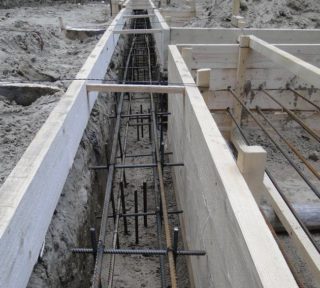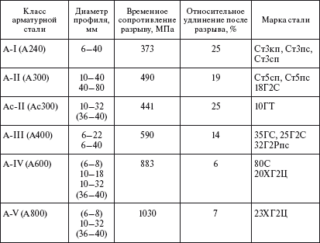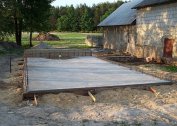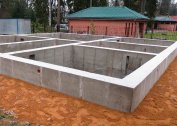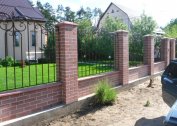Each construction begins with a reliable foundation. The strip foundation is the most common design in low-rise construction. The calculation of reinforcement for the strip foundation is important already at the stage of design and delivery of building materials. The calculation is entrusted to professionals or carried out independently, having studied the guidance documents.
Reinforcement purpose
Strip foundations are a monolithic reinforced concrete foundation structure. The base is made directly at the construction site.
Reinforced concrete - concrete, inside of which there is a metal frame made of reinforcement. Metal can withstand lateral loads that create:
- bottom-up - heaving processes of the soil;
- top to bottom building mass.
Pure concrete has poor resistance to lateral loads. Steel embedded in the structure can make the foundation tens of times stronger.
Under load, each meter of concrete can stretch by 2–4 mm, while steel from 4 to 25 mm. Concrete is much more resistant to compression.
Algorithm for working with pressure from above:
- The load presses on the surface of the foundation, which begins to bend.
- The top layer of concrete resists compression, the top row of reinforcement is inactive.
- The bottom of the foundation is trying to lengthen.
- The lower row of rods resists tensile loads.
When the pressure from the ground is from below, reinforced concrete "works" in the opposite direction - the lower layer of concrete counteracts compression, and the upper row of reinforcement does not allow it to collapse from tension.
Regulations
Strip foundations in low-rise construction relate to reinforced concrete structures without prestressing reinforcement.
Such bases are designed and built in accordance with the code of rules of the joint venture 52-101-2003. Section 5.2 of the document defines the grade of steel, the shape and geometric dimensions of the bars. Section 8.3 “Reinforcement” discusses the number and size of reinforcing elements, their relative position in the concrete body. It also indicates the location of the fittings, the rules of connection at intersections.
The information contained in the document is enough to understand how to calculate the reinforcement for the foundation, to calculate the amount of material.
Assortment of metal products
For reinforced concrete structures use reinforcement:
- hot-rolled, smooth or with a periodic profile (annular or sickle-shaped) with a diameter of 6 to 40 mm;
- thermally and mechanically hardened with a periodic profile, 6–40 mm;
- cold-deformed periodic section (3–12 mm).
It is recommended to use smooth reinforcement with a class of at least A-240 (A-I). For a ribbed (periodic profile), class A-300 and higher is selected.
In areas where the temperature drops below 30 ° C, class A-300 is prohibited.
It is preferable to use products with a periodic profile - with tides in the form of rings or sickles. Irregularities increase the adhesion area of the rods to concrete and the strength of the entire structure.
Recently, composite fittings have appeared on sale. The manufacturer recommends using it instead of steel products.
SP 295.1325800.2017 does not allow the use of composite products for foundations.
Bookmark layout
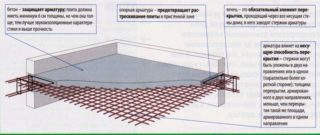 Precisely calculate the reinforcement on the foundation allows section 8.3. Code of Practice.
Precisely calculate the reinforcement on the foundation allows section 8.3. Code of Practice.
Protective layer
In reinforced concrete foundations for steel parts, a protective layer is provided that provides:
- joint work of all parts;
- protection of rods from aggressive environmental influences (moisture), chemicals;
- fire resistance.
In the soil, the layer thickness (the distance from the rods to any external edge of the concrete) is selected at least 40 mm. In the open air, the distance is reduced to 30 mm.
Distances between fittings
The distance between the individual rods is chosen not less than the diameter of the rod. In addition, for horizontal lower rows, the distances are more than 25 mm, and for the upper rows - 30 mm.
In cramped conditions it is allowed to have reinforcement in bundles.
Longitudinal reinforcement
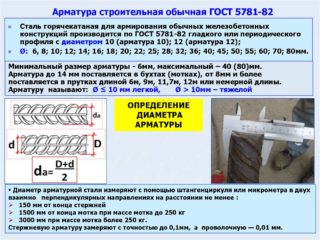 For the foundation side up to 3 meters long, it is permissible to use rods with a diameter of 10 mm, if the side exceeds 3 m - no thinner than 12 mm.
For the foundation side up to 3 meters long, it is permissible to use rods with a diameter of 10 mm, if the side exceeds 3 m - no thinner than 12 mm.
The total cross section of the bars of the longitudinal reinforcement is chosen at least 0.1% of the cross section of the foundation.
For example, for a tape with a width of 40 and a height of 100 cm, the cross-section is 400x1000 = 4,000,000 mm². The total cross section of all longitudinal bars should be 0.1%, i.e. 400 mm².
You can select the desired number of rods using the table.
| Bar diameter, mm | The total cross section of the rods depending on the number of rods, mm | ||||||||
| 1 | 2 | 3 | 4 | 5 | 6 | 7 | 8 | 9 | |
| 10 | 75 | 155 | 235 | 315 | 390 | 470 | 550 | 630 | 710 |
| 12 | 115 | 225 | 340 | 450 | 565 | 680 | 790 | 900 | 1020 |
| 14 | 155 | 310 | 460 | 615 | 770 | 925 | 1080 | 1230 | 1385 |
| 16 | 200 | 400 | 605 | 805 | 1010 | 1210 | 1410 | 1610 | 1810 |
According to the table, for the foundation with a cross section of 40x100 cm, 6 longitudinal rods of 10 mm or 4 pieces of 12 mm are necessary.
The distance between the axes of the longitudinal segments of the reinforcement should not be more than 40 cm, and the rods in one level cannot be less than 2. One reinforcement is used only in foundations thinner than 15 cm.
Transverse reinforcement
Tasks of transverse vertical reinforcement:
- limit cracking;
- to keep longitudinal bars from displacement;
- fasten the longitudinal rods from buckling in any direction.
Cross parts are installed wherever the longitudinal rods pass.
The diameter of the transverse reinforcement for strip foundations cannot be less than 25% of the largest diameter of the longitudinal rods, but in any case the minimum diameter is 6 mm.
The installation step of the transverse elements is not more than 50 cm, with a rib height of more than 15 cm.
Rebar calculation
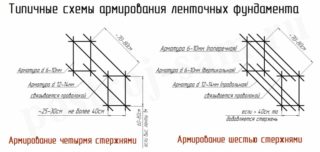 It is easier to calculate the reinforcement for the foundation on a specific example of a house measuring 6x10 meters. Cross section of the foundation 50x100 cm.
It is easier to calculate the reinforcement for the foundation on a specific example of a house measuring 6x10 meters. Cross section of the foundation 50x100 cm.
The required number of hardware
According to the table, 4 longitudinal parallel rods with a diameter of 12 mm are required.
The total perimeter of the foundation is 6 + 6 + 10 + 10 = 32 meters.
In total, you need 128 (32x4) meters of reinforcement.
The length of the bars on sale is 3, 6 or 11, sometimes 12 meters. Therefore, it is not possible to select the exact rod for each side.
Longitudinal rods have to dock. Joints will be at angular intersections. If P- or G-shaped rods are used in the corners, they should be buried in the wall by at least 40 cm.
According to the set of rules, the overlap of the rods should be at least 30 diameters. For 12 mm fittings - at least 36 cm.
In order not to have to additionally purchase and deliver building materials, reinforcement is purchased with a margin of 10-15% of the estimated amount. Fifteen percent of 128 is 19.2 meters.
As a result, they acquire 128 + 19 = 147 meters of 12 mm bar for longitudinal reinforcement.
Counting transverse and vertical elements
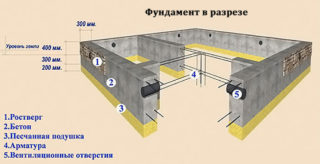 Transverse and vertical reinforcement elements are welded, twisted with knitting wire or bent in the form of a rectangle.
Transverse and vertical reinforcement elements are welded, twisted with knitting wire or bent in the form of a rectangle.
Vertical components are best done longer than the height of the tape - they can be drowned in the ground. This will make installation more convenient.
The sides of the horizontal-vertical rectangle are less than the foundation dimensions by at least 10–15 cm. To leave a protective layer of concrete around the rods.
Putting together the sides, one obtains the number of reinforcement per rectangle: 30 + 30 + 90 + 90 = 240 cm. Taking into account overlaps, another 10 cm is added. As a result, the length of each element is taken to be 2.5 meters.
In each corner, you need to install two rectangles, all on the foundation 4x2 = 8 pieces.
The maximum distance between the elements in straight sections is 50 cm. When constructing large-sized houses - 30 cm.
The lengths of the sides for further calculations without taking into account angular intersections are equal to:
- Short 600 cm minus 2 angles of 50 cm - 500 cm.
- Long 1,000 cm minus 2 angles of 50 cm - 900 cm.
On each short side, in addition to the corner, 9 more rectangles are needed. In the long side set 17 elements.
The total number of diameters will be: 8 angular, 9 + 9 = 18 for the short sides of the foundation and 17 + 17 = 34 for the long.
The total number of vertically horizontal jumpers will be: 9 + 18 + 34 = 61 pcs. The length of each 2.5 meters. Total fittings with a diameter of 6 or 8 mm will need 61x2.5 = 152 meters. Purchasing material with a margin of 5%, therefore, 160 meters.
Total amount
The total amount of material needed to reinforce the foundation with sides of 6 and 10 meters:
- for longitudinal rods - 147 meters of reinforcement 12 mm. The weight of one meter will be 0.88 kg, and the total weight: 147x0.88 = 130 kg.
- 160 m rods with a diameter of 8 mm are acquired for vertical and transverse rods, their mass is: 160x0.39 = 62 kg.
In addition to these materials, they acquire a knitting wire with a diameter of 2.5 to 4 mm. She will need about 50 meters.
The number of elements varies depending on the size of the foundation and full load. In these cases, you need to calculate by the same method.
You can calculate the number of reinforcement for the construction of a strip foundation yourself. Having drawn a drawing and placing all the necessary elements on it, it will take half an hour to calculate the need for materials. This will save on delivery in the event of a shortage of products, as well as to verify the integrity of the contractor, if the work is performed by an external organization.
